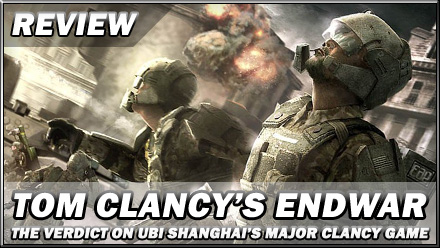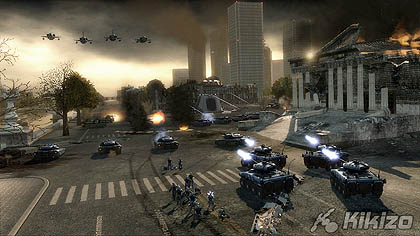Tom Clancy's EndWar
If everyone dies then is there a reason to even bother?
| Version 360, (PS3, PC) | Developer Ubisoft Shanghai | Publisher Ubisoft | Genre Real-time tactics |
||||

Page: 1 2
Take the Creative Assembly's Shogun: Total War, trade in its samurai armour for a nano-composite flame-retardant vest, force-feed it passable three-dimensional models and teach it to speak when spoken to and you'll have something a lot like Tom Clancy's EndWar, the first of Ubisoft's forays beyond Clancy shooter orthodoxy. On the Xbox 360 at least, you'll also have an immensely satisfying, startlingly intuitive real-time tactics game which wees on most of its console competitors from strategic bomber altitude. If the world absolutely must come to an apocalyptic finale this winter, at least it'll do it in style.
EndWar takes place during a sort of nostalgic gun-nut's near-future fantasy in which the Cold War never really ended, with the globe split between the US, Europe and Russia, behind whose lip service to the notions of peace and harmony lurk battalion upon battalion of frighteningly well-armed combat troops. Once you've fought your way through the hour-long story prelude, which spoons out the basics of the interface, mode and unit options chunk by chunk, you'll be able to pick a faction and unleash your persistent task force on a world map broken into hexagons, the object being to either capture all three capital cities or seize 28 territories.
As in the Total War games, the broad strategic thrust of your operation takes place in turns, but individual battles unfold in real-time upon a local area map. There's a certain science to picking fights on the overmap - whether to engage in a costly, three-turn struggle for control of a metropolis, or whether to lash out at the supply territories which surround it - but unlike in Total War this aspect is never remotely like a game in its own right, remaining firmly secondary to the microcosmic engagements. While troops KIA are gone forever, depleted units are restored to full health between battles, which somewhat takes the consequence out of rash decision-making in the fray.
You will, however, still grow hugely attached to your toy soldiers thanks to the experience and upgrades system. Troops rank up between battles once they've accumulated enough of the former, and you can buy the latter using credits awarded for victories and skilful generalship. Upgrades range from boring passive stat boosts to exciting secondary abilities like mine-laying, and pleasingly enough most of them alter the appearance of your unit: a transport with an attack buff will sport a fancy new missile turret, and your helicopter gunships' enhanced defence ratings will be manifest as clouds of swirling tinsel chaff. Needless to say if any of your tricked-out instruments of war bites dust it's back to square one, though you can fly in transport choppers mid-battle (themselves vulnerable to assault) to airlift defeated units and their precious upgrades to safety.
Each faction has access to the same roster, a few negligible differences in speed, attack and defence power aside, and thus the same rock-paper-scissors order of battle. Tanks blow the stuffing out of troop transports but are so much target practice for gunships, who in turn take a pasting from transports. Engineers are capable of laying the smackdown on all vehicles providing they're in cover, but soon get stuffed when pitted against riflemen, and artillery pieces kick the crap out of anything on the ground as long as they're kept well to the rear.
As you'll rarely be able to tailor your strategy exactly along these clinical lines, much of the challenge lies in prodding at your enemy's weaknesses as best you can while relying on hit-and-run manoeuvres, stalling tactics and surgical deployment of secondary weapons to make up for your own. Your superior officer (the US gets Baldwin-Lite, Russia a simpering Bond villain and Europe somebody who looks and sounds like that African bloke from Gladiator) will give you a few tips on the opposing general's unit choices before you wage war, and making your own on this basis is usually advisable. Reinforcements can be called in mid-battle, providing you have enough Command Points, which are awarded for capturing satellite Uplinks and punishing the foe. You can field up to twelve units at a time.
The command vehicle deserves special mention inasmuch as whether you have one determines how far you can see. With it on the battlefield you have access to the "SitRep", a tactical overview which lets you pan across the map as a whole and issue orders with greater freedom; without it, the camera is locked to your currently selected unit, though you'll still have access to the minimap.
Page: 1 2













 Satoru Iwata Video Interview - the late Nintendo president spoke with Kikizo in 2004 as 'Nintendo Revolution' loomed.
Satoru Iwata Video Interview - the late Nintendo president spoke with Kikizo in 2004 as 'Nintendo Revolution' loomed. Kaz Hirai Video Interview - the first of Kikizo's interviews with the man who went on to become global head of Sony.
Kaz Hirai Video Interview - the first of Kikizo's interviews with the man who went on to become global head of Sony. Ed Fries Video Interview - one of Xbox's founders discusses an epic journey from Excel to Xbox.
Ed Fries Video Interview - one of Xbox's founders discusses an epic journey from Excel to Xbox. Yu Suzuki, the Kikizo Interview - we spend time with one of gaming's most revered creators.
Yu Suzuki, the Kikizo Interview - we spend time with one of gaming's most revered creators. Tetris - The Making of an Icon: Alexey Pajitnov and Henk Rogers reveal the fascinating story behind Tetris
Tetris - The Making of an Icon: Alexey Pajitnov and Henk Rogers reveal the fascinating story behind Tetris Rare founders, Chris and Tim Stamper - their only interview? Genuinely 'rare' sit down with founders of the legendary studio.
Rare founders, Chris and Tim Stamper - their only interview? Genuinely 'rare' sit down with founders of the legendary studio. The History of First-Person Shooters - a retrospective, from Maze War to Modern Warfare
The History of First-Person Shooters - a retrospective, from Maze War to Modern Warfare